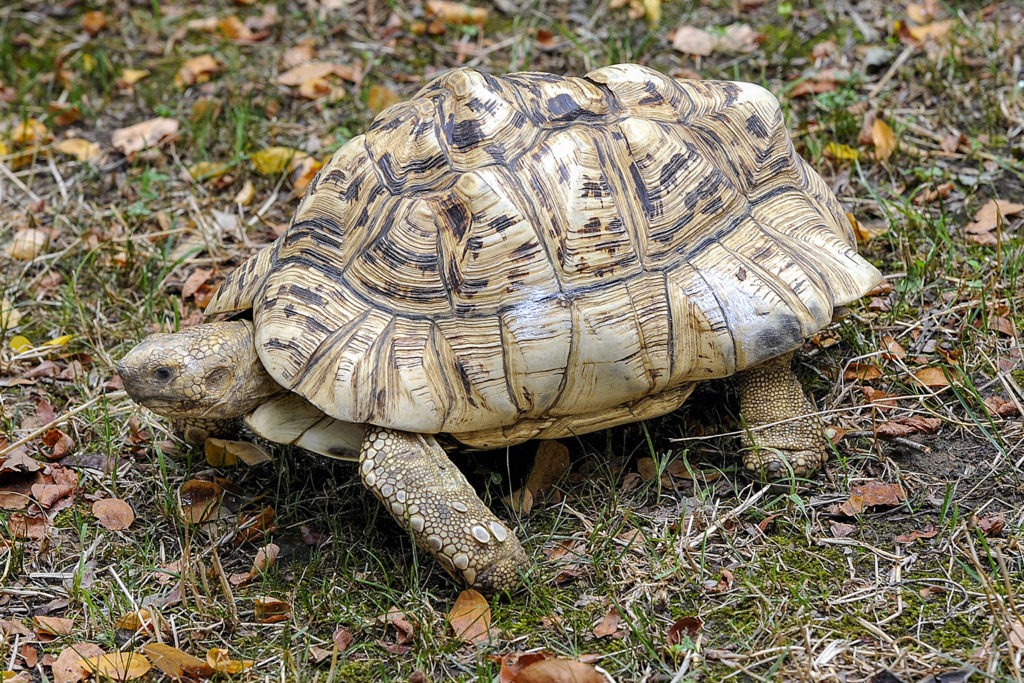Overview
“Where I live”
Leopard tortoises are native to the dry savannahs of central and southern Africa. They belong to the family of “land tortoises” known as Testudinae. Africa supports more species of land tortoise than anywhere else.
The Maryland Zoo has leopard tortoises on exhibit in its African Journey portion of the Zoo.
“How I live there”
Leopard tortoises are well adapted to the semi-arid conditions of the savannah, and do not tolerate damp or cold well. Their days are geared to the fluctuating temperatures of their arid environment. As with all arid regions, the African savannah experiences extreme temperature fluctuations over a 24-hour period. It gets very hot during the day when the sun is burning brightest, but cools off considerably when the sun goes down. Leopard tortoises are most active early in the morning and just before the sun goes down, when the temperature is most moderate. They seek shelter during the hottest part of the day and go to sleep early to avoid the cold.
When awake, leopard tortoises spend most of their time grazing on mixed grasses. Like other turtles and tortoises, they have no ears but can sense vibrations that help them navigate their environment. They have a keen sense of smell that probably helps them locate food. They have no teeth (no turtle or tortoise does), but they bite and rip at food with their hard, sharp, beak-like mouths. Leopard tortoises also eat the fruit and pads of prickly pear cactus and other succulents that provide them with water. They store water in large anal sacs that take up most of the space in their abdominal cavities. This is an important physical adaptation to their arid environment.
“Making my mark”
Leopard tortoises are a signature animal of the African savannah and are one of the most successful species in this habitat. They are beautiful tortoises easily recognized by their domed carapaces with contrasting black and yellow patterns. (The shell’s top is the carapace. The shell’s bottom is the plastron.)
Distinguishing a male leopard tortoise from a female can be difficult on sight, although males typically grow larger than females. The largest leopard tortoises on record have measured over two feet long and weigh about 80 pounds, but these are rare giants of the species.
“What eats me”
Few animals attempt to prey on tortoises, including leopard tortoises. It’s a losing battle. They may not be the quickest animals out there, but their main form of defense – pulling the entire body inside an impregnable shell – is virtually foolproof. Leopard tortoises also have another defensive weapon that they use to deter predators such as man that might try to move them. If you were to try to pick up a leopard tortoise, it might very well evacuate its bowels and much of its stored water all over you.
Raising Young
Turtles and tortoises don’t exactly “raise young.” They aren’t big on parental involvement. Males exit the scene after mating. Females excavate nests, lay their eggs, cover them up, and leave. Mating season itself is an active time, though, with male and female leopard tortoises becoming rather aggressive. Males and females will butt and ram other tortoises with which they are competing for mates.
Leopard tortoises nest between May and October. Females dig a nest about 10-30 cm deep and lay from 5-30 eggs at a time. Leopard tortoise eggs incubate for a prolonged but variable period, ranging from approximately 5 months to over a year. When ready to hatch, each hatchling has a small egg tooth that it uses to break out of its shell. Leopard tortoise hatchlings are brightly patterned at birth, and entirely on their own. They immediately start to feed on a variety of plants, but seem to prefer succulents, possibly because of the higher water content.
Turtle, tortoise, or terrapin?
All turtles, tortoises, and terrapins are reptiles belonging to the taxonomic order Chelonia(from the Greek for “tortoise”). All have scales, lay eggs, and are ectothermic. The different common names can be confusing and aren’t perfect distinguishers, but generally the term “tortoise” refers to a land-dweller. Tortoises have strong legs and round, stumpy feet made for walking on land. They tend to live in dry, hot places. Turtles spend most of their time in water and terrapins live on land and in water, and are always found near water.
Conservation
Leopard tortoises are the most widespread tortoise in sub-Saharan Africa. They are not considered threatened, but they are under increasing pressure from habitat loss. Historically, they also have been heavily exploited by the pet trade. They are hunted and consumed locally for food. Leopard tortoises are increasingly being bred in captivity, but many are still taken from the wild to be sold as pets. Any potential owner of a pet leopard tortoise needs to remember and consider carefully that these tortoises, like many species of tortoise, can live a very long time. Their lifespan in the wild is not well known, but their average lifespan is likely between 80 and 100 years.
Taxonomy
- Kingdom: Animalia
- Phylum: Chordata
- Subphylum: Vertebrata
- Class: Reptila
- Order: Testudines
- Family: Testudinidae
- Genera: Stigmochelys
- Species: pardalis


